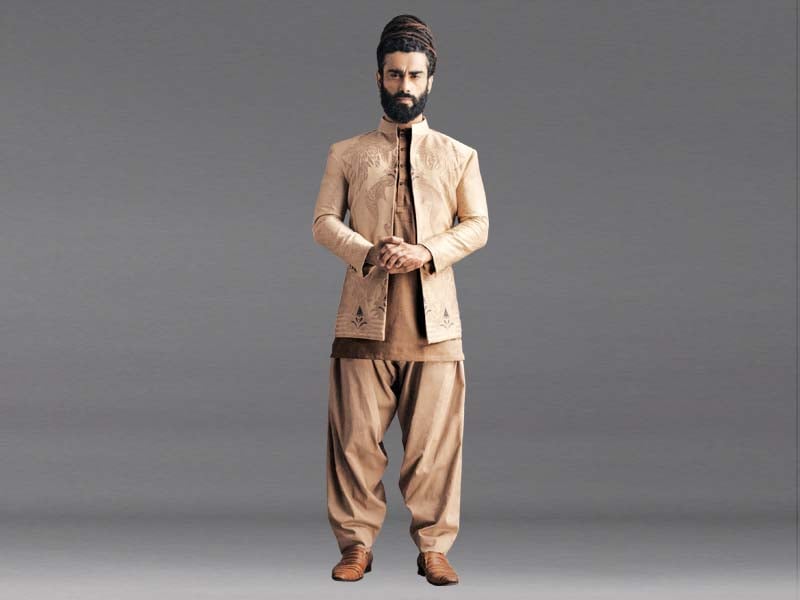
Arsalan Iqbal recently competed in Woolmark Prize’s regionals in India. This being his first time, we talk to him about his brand, the philosophy behind his designs and the unforgettable experience of representing Pakistan
When did you start your label?
I launched House of Arsalan Iqbal in January 2013, before that, I was one of the designers behind the label Arsalan & Yahseer, which started in 2011.
How did the Woolmark competition come about?
The Woolmark Prize nominees are initially recommended by PFDC in Pakistan, after which they are shortlisted and selected by Woolmark Prize International, Australia. I must mention that Woolmark, which started in 1954, provides extraordinary opportunities for its nominees and winners. Even iconic designers such as Karl Lagerfeld and Yves Saint Laurent were introduced through this platform.
What do you win if you get selected at the regionals?
Each designer is asked to produce a capsule collection, comprising of six garments to showcase the beauty and versatility of Merino wool. The winner of the regionals then goes on to take part in the finals, which are held in London, Paris or Florence. Additionally, the winner of the regionals gets a prize of $50,000 to support their business and the chance to connect with international buyers on Woolmark’s panel, who place initial orders and provide great networking opportunities. The winner of the final gets $100,000 and their winning collection is stocked all around the world in high-end retail stores.
Tell us more about your entry. Why did you choose to showcase shalwar kameez?
My entry comprised of an evening jacket with a mandarin collar in jacquard, hand-woven Merino wool, with a kurta underneath and a pleated shalwar, made out of a hand-woven cotton and Merino wool fabric. I also made customised jacquard duffle bags and shoes to go with the outfit. As for why shalwar kameez, there were a few reasons. I wanted my entry to reflect the design and cultural sensibilities of Pakistan, fluid silhouettes from the Indian-subcontinent have been a raging trend in European fashion, and most importantly, I am a Pakistani catering to the Pakistani market. I have to make sure whatever I make is commercially feasible in both global and domestic markets.
Why did you pick the Houbara bustard bird as your key source of inspiration?
I chose this desert bird because I wanted to raise awareness about its declining population. Houbara bustard or tiloor is one of our national birds, which are hunted by Arabs every year, so much so that it is nearing extinction in the wild. Pakistani law did ban the hunting of this particular bird in 2014, but the Supreme Court lifted the ban citing diplomatic reasons. Through my work I want to raise awareness about this issue. I may not be able to save the birds but I’d like to at least get people to talk about it.
You made some really cool accessories, tell us more about them?
We made a few customised duffle bags, Peshawari sandals and loafers all using 100% hand-woven, Merino wool. They were well received in India and the greatest compliment was when Manish Malhotra, who was one of the judges, asked me to make him one!
Why do you think natural fibres have fallen out of favour? Is the choice about economics or because synthetic textiles are easy?
I think it’s a bit of both. In a world where ready-to-wear garments are so price-competitive, it’s nearly impossible to make clothes using luxury fibres. I also think it’s about awareness, a lot of people aren’t informed about how natural fibres are superior in quality, they possess elements which synthetic fibres never can. It comes as a shock to many that wool can be summer friendly! Synthetic blends just don’t cut it.
Do you plan to retail your Woolmark collection?
Yes, but I am currently only taking custom orders for these pieces at my stores, as I’m also preparing to go to Pitti Uomo in Italy early next year for an exhibition. It’s a platform where designers and buyers from across the world gather for menswear fashion and trends. I will be the first Pakistani to take part there. It’s a real honour.
Now that you have been through the experience of participating in a competition, what has been your biggest learning as a designer?
We, or at least I, as a designer tend to get lost within the domestic market. Sometimes it’s impossible to see the bigger picture and broaden prospects in the international markets. Personally, the experience of Woolmark was extremely fulfilling and a great learning experience as a designer. The exposure and the gruelling preparations in order to match up to international standards, was a big stepping-stone. At the end of it I think I came out a better designer, with an improved skillset and stronger business acumen to share with my peers.































































COMMENTS
Comments are moderated and generally will be posted if they are on-topic and not abusive.
For more information, please see our Comments FAQ